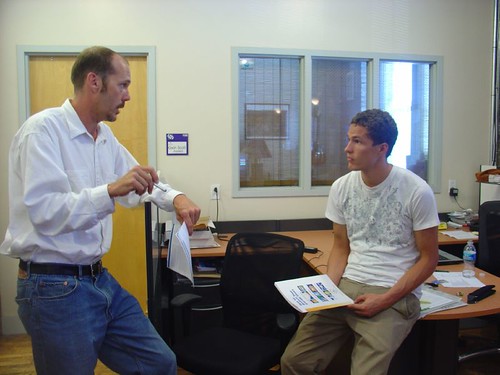
Office buildings in the U.S. use an average of 17 kilowatt-hours (kWh) of electricity and 32 cubic feet of natural gas per square foot annually. In a typical office building, lighting, heating, and cooling represent about 65 percent of total use, making those systems the best targets for energy savings.
Emerge Memphis is located in a four-story building downtown that was renovated in 2002. There are twenty-six incubator businesses that occupy three levels. The top floor is vacant pending renovation. The high ceilings, exposed beams and ductwork made it look very cool. The 72 degree setting on the air conditioner made it feel very cool. Maybe a little too cool. Our first tip: Set the thermostat at 78 degrees in the summer.
Tom, the Emerge Memphis employee who called us, said that they were having difficulty managing their HVAC system which was set up by one company and now managed by another. Without a maintenance person on staff, they were relying on the receptionist to monitor the system. Tom said that the temperatures didn't seem to set accurately and they didn't know if the system was shutting down at night and on weekends.
The Commercial Energy Advisor strongly recommended checking the HVAC system and doing whatever was necessary to get it operating properly.
Next we looked at the lighting.

Office spaces require 20-50 foot candles of light depending on the work being performed in the area. They had 35 foot candles in the copy room. It was decided to remove 16, 34 watt tubes. This left 25 foot candles which is sufficient for the tasks being performed in the area. This alone will save approximately $15/month in energy and will lower the amount of bulbs needed reducing their bulb replacement cost. On a bigger scale it's 16 bulbs being removed from the waste stream and 540 watts less that TVA will have to generate. The Commercial Energy Advisor and Tom decided to look for other areas where the lighting could be reduced.
As we looked around the building we made some other suggestions for improving their energy-efficiency like incorporating motion sensitive lighting in rooms that aren't used very much (i.e. bathrooms and storage rooms), weatherstripping external doors and stairway doors, caulking around windows, closing blinds, etc.
Finally, we encouraged Tom to utilize the energy-saving tools on our website created especially for commercial customers.
If you would like a Commercial Energy Advisor to come to your business (or school, church, etc.) call 528-4270 or email crc@mlgw.org.

No comments:
Post a Comment